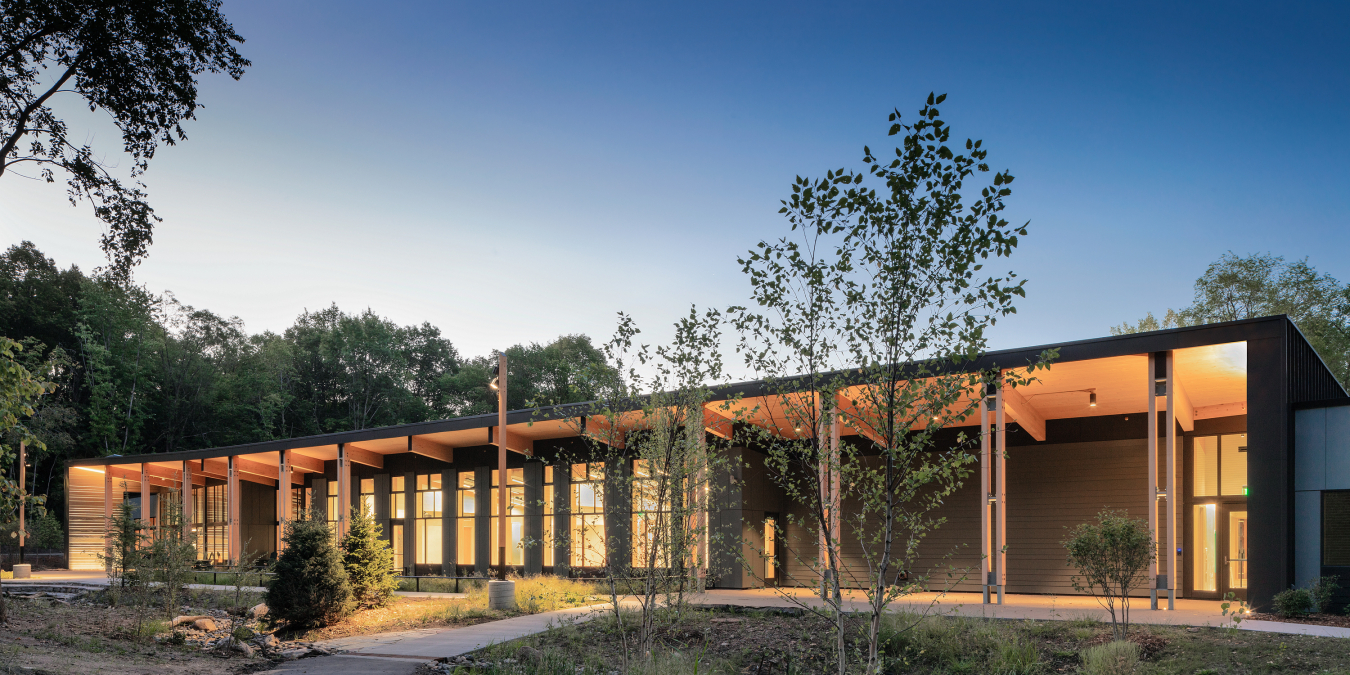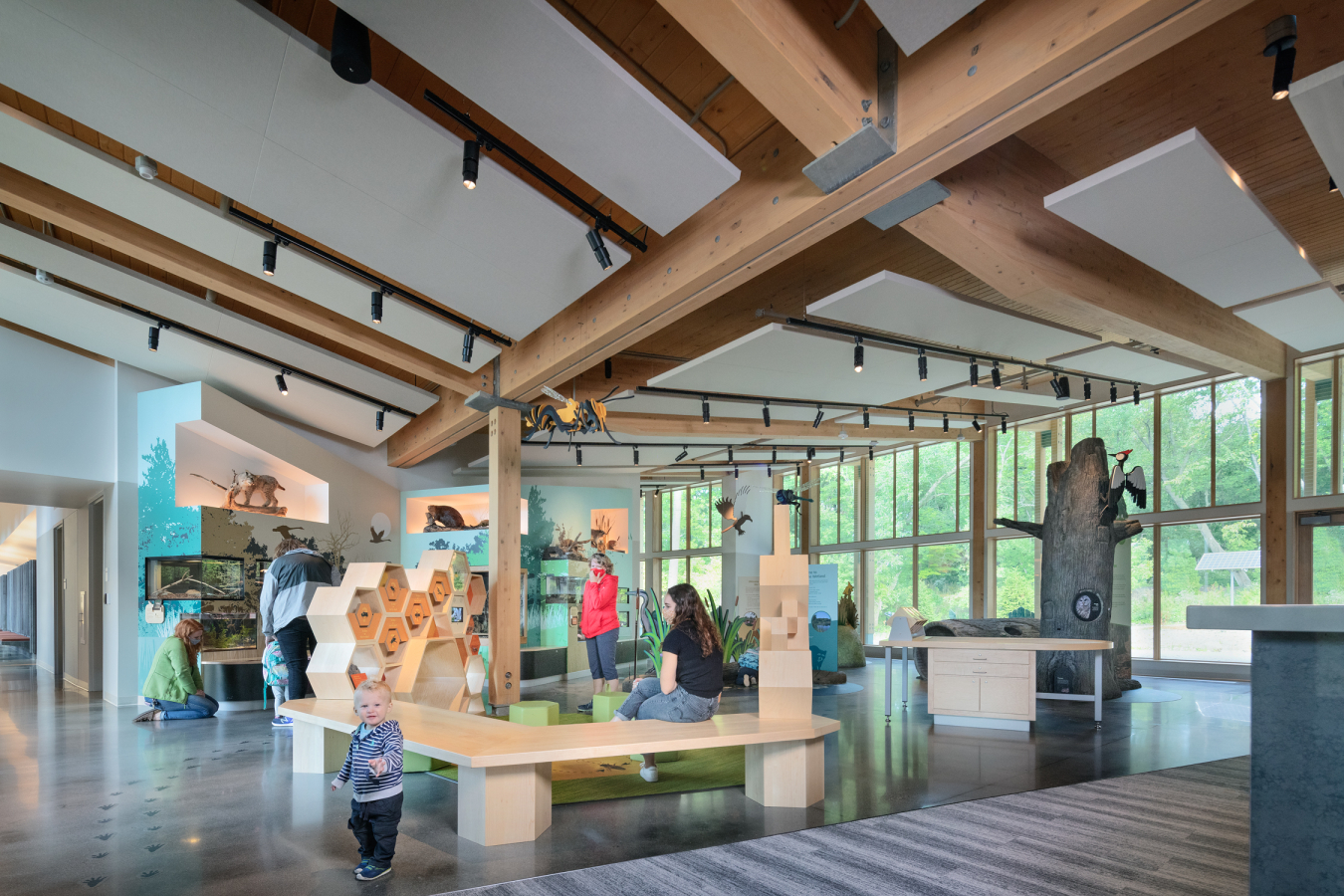
The Westwood Hills Nature Center in St. Louis Park, Minnesota, was designed as an energy-efficient building with geothermal heat pumps providing heating and cooling. Photo from Pete Sieger Photography
Fast Facts
Location: St. Louis Park, Minnesota
System Size:
- 13,500-square-foot building
- 32 boreholes drilled 200-250 feet deep into an aquifer
- 1 water–to–water heat pump
- 15 water–to–air heat pumps
Download the full case study for additional fast facts.
A Hub for Education
The Interpretive Center building at Westwood Hills Nature Center, run by the City of St. Louis Park, Minnesota, opened July 6, 2020. The energy-efficient building—both an educational facility and a local gathering space—is a hub for outdoor education, natural history, and recreational activities. Surrounded by 160 acres of marsh, woods, and prairie, the facility offers a haven in the city for people to connect to nature.
Lasting Design
Before breaking ground for the new Interpretive Center building in 2019, a team of four city staff spent four years planning the project with architects, engineers, and city leaders. Together, they decided that balancing electrical consumption and production to try to maximize efficiency was most aligned with the city’s commitments to the future.
During this time, city staff also met with local residents to explain the benefits of an energy-efficient facility, built to last more than 50 years with minimal maintenance needs. Feedback from these meetings was incorporated into the design where appropriate.

The Westwood Hills Nature Center Interpretive Center surrounds visitors with educational opportunities—as well as comfort provided by the geothermal heat pump system that heats and cools the air around them and the radiant flooring under their feet. Photo from Pete Sieger Photography
Results:
- Reduces annual energy costs by $6,750—a 35% savings
- Building envelope provides a 20% energy savings and improves user comfort
- 50-year building life span
Unique Features:
- Borefield located under the parking lot and sidewalk
- 3,000-square-foot radiant floor heated by a water–to–water heat pump
Prioritizing energy efficiency in the building’s design, project architects and engineers used a combination of passive and active design strategies. Primary among the active strategies was the building’s geothermal heat pump (GHP) system.
“Mechanical engineers looked at every possible strategy to reduce the amount of electricity needed to run a building like this in Minnesota’s cold climate,” said Mark Oestreich, manager of the City of St. Louis Park Nature Center. “Geothermal was one of the strategies we chose that made sense to help us achieve this goal.”
System Draws Heat From Aquifer Hundreds of Feet Below
The Interpretive Center’s geothermal, closed-loop heat pump system features 32 boreholes drilled vertically nearly 250 feet down into an aquifer. To preserve the native prairie surrounding the building, the borefield is located under the 500–square–foot parking lot and sidewalk.
Nearly 3.5 miles of underground piping circulates 2,500 gallons of 30% propylene glycol water through the geothermal heat pump system. Heating and cooling for the 13,500–square–foot building is provided by 15 water–to–air heat pumps. A single water–to–water heat pump serves the 3,000–square–foot radiant floor.
100% Satisfied
“The Interpretive Center did a great job of laying the foundation for what our city council expects from our buildings,” said Emily Ziring, St. Louis Park sustainability manager. “The center also exemplifies our high standards and shows us leading by example.”
In addition to the geothermal heat pump system, active performance strategies included daylighting and a 122–kW rooftop solar photovoltaic array. Passive strategies included solar shading and natural ventilation for cooling and thermal mass for heating. The high-performance building envelope reduces energy use by 20% and improves staff and visitor comfort.
Since opening, the Westwood Hills Nature Center has helped thousands of visitors learn about the woods, marsh, and prairie surrounding the Interpretive Center.
“Moving into this building, I thought we’d have to sacrifice some comfort to meet our energy goals, expecting it to be warmer in summer and cooler in winter. But surprisingly, it’s been consistently comfortable year-round.”
Mark Oestreich, Westwood Hills Nature Center Manager, City of St. Louis Park
Contacts:
For questions about this case study, contact Emily Ziring, EZiring@stlouisparkmn.gov.
For any website technical issues or general questions about geothermal heat pumps, contact DOE.Geothermal@ee.doe.gov.
Printable Version
Download the printable Westwood Hills Nature Center case study or visit the Geothermal Heat Pump Case Studies page to see more examples of geothermal heat pumps in action.


